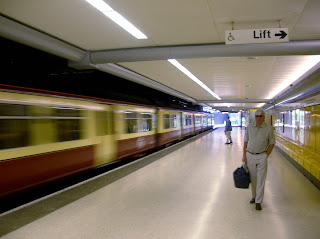Lesson 6
I have altered the levels on these 2 photographs to get the correct shadows and highlights. With the top photograph I used the eyedropper tool to select the shadow and highlights which gave the best results. On the second image I determined the shadows and highlights by altering the sliders myself as this worked better.
I have altered the contrast on these 4 images using curves. I have produced 2 copies of both one where the contrast is correct and one where it is extreme.
I corrected the colour cast on this top photo by using colour balance. To remove the cyan tint I added red to the image.
I removed the yellow/green tint to the photo by correcting the colour balance in curves. I selected the shadow, highlight and grey tone in the photo with the eyedropper tool to do this.
I did the same with this photo. I find using curves to remove colour casts is much easier than changing it manually in colour balance.
I removed the red-eye from this image of a dog by selecting the dog's eyes using the lasso tool. I then went on replace colour, selected the red pixels and desaturated and darkened the colour so it was black rather than red. I found this better than using the red-eye tool as it allows you to keep the colour of the yellow iris.
To begin with I used the colour replacement tool to change the colour from red to blue. However I found a much quicker and easier way to do this was by going into replace colour and using the eyedroppers to target the colour and alter it using the hue, saturation and lightness sliders.
To make the result more successful I found that when using the colour replacement tool you need to try and paint it all using one stroke. If a bit gets missed its best to zoom in and use a small brush to correct the colour.
Here I matched the colour of the first photo to the second by using match colour. In this I had to select the source and target image.
I changed the mood of this image by removing most of the colour in it by reducing the saturation.
I converted this image to black and white. I then altered the different tones by clicking on certain tones in the image and dragging to make the tone darker or lighter. This is how I produced this extreme result.
I converted this image to black and white and produced two different results by using the individual colour sliders to change the contrast.
I converted this image to black and white and then applied a green tint to it using the hue and saturation sliders.
First of all I converted this image to black and white and gave it a sepia tint to make it look like an old postcard. I then used one of the filter presets 'cooling filter' to give a different effect.
To get this effect I went to the filter gallery and added various filters to this image. I used fresco, poster edges and watercolour. In this gallery you are able to layer up filters and choose which goes on top of what.
To remove the various scratches on this image I applied the filter, dust and scratches to do this.
To create these 2 different lighting effects I used the lighting effects filter to do this. I used flashlight and orbit.
I used the unsharpen mask to improve this image of an insect and make it more in focus.
As a final exercise on these four images I corrected the contrast and colour balance using curves, altered the sharpness using unsharp mask and matched the colours of the two landscapes and two portraits using match colour using the top image as the source. After this session I feel much more confident on how to adjust images and the best methods to do so.











































No comments:
Post a Comment